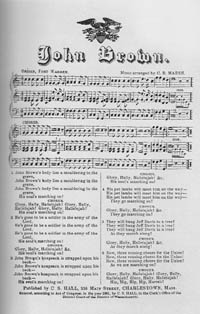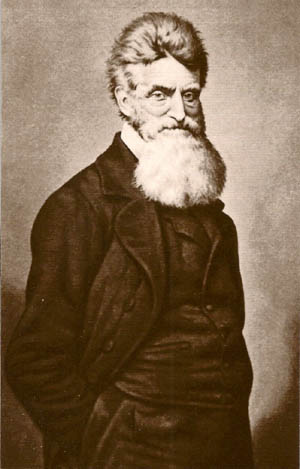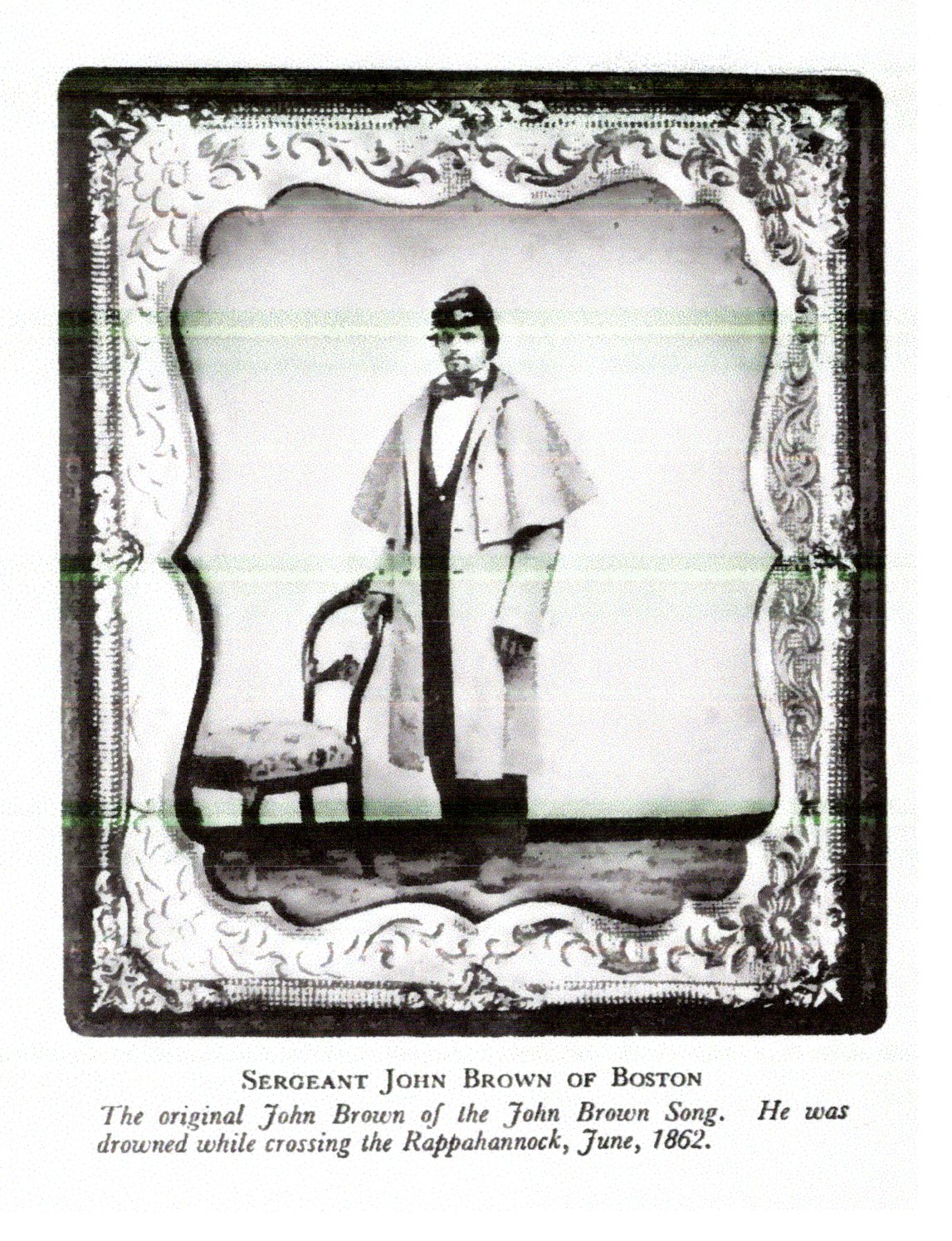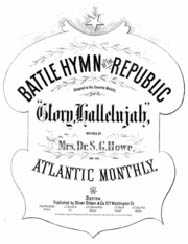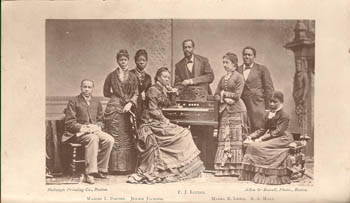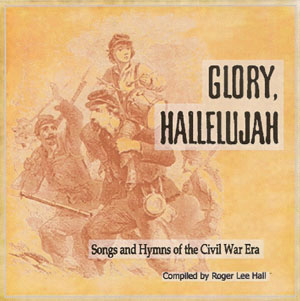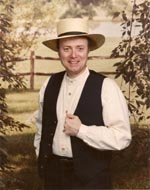
- The Story of the "John Brown" song
- Who wrote the tune?
- The "Glory, Hallelujah" Chorus
- Singing for a U.S. President - "Go down, Moses"
- A Valuable Disc with Civil War Music
- Related Links
The Story of the John Brown song
by Roger L. Hall, AMP
In his book, John Brown, Abolitionist, David S. Reynolds wrote:
"No one in American history--not even Washington or Lincoln--was recognized as much in drama, verse and song as was Brown. One piece, the song, "John Brown's Body," was unique in American cultural history because of the countless transformations and adaptations it went through."This song known as "John Brown's Body" (first titled, "John Brown") was first published in July of 1861, and includes the Glory Hallelujah Chorus.
It was reportedly first sung at Fort Warren in Boston on May 12, 1861, and later on July 18 by the 12th Massachusetts Volunteer Infantry.
Irwin Silber, in his book, Songs of the Civil War, provides a detailed description:
"By a strange quirk of history, together with the fact that there are few, if any, more common names than John Brown, "John Brown's Body" was not composed originally about the fiery Abolitionist at all. The namesake for the song, it turns out, was Sergeant John Brown of Boston, a Scotsman, a member of the Second Battalion, Boston Light Infantry, Massachusetts Volunteer Militia. Sergeant John Brown, as luck would have it, also happened to be a singer, a second tenor in the battalion glee club. Among the most popular airs sung by the choristers was an old Methodist tune which went:
Say, brothers, will you meet us,
Say, brothers, will you meet us,
Say, brothers, will you meet us,
On Canaan's happy shore.The new song based on that Methodist tune jokingly begins:
John Brown's body lies a-mouldering in the grave
John Brown's body lies a-mouldering in the grave,
John Brown's body lies a-mouldering in the grave,
His soul goes marching on."
In Vera Brodsky Lawrence's lavish book, Music For Patriots, Politicians and Presidents, she includes an illustration of the first known printing of the song [shown at left], arranged by C.B. Marsh and copyrighted on July 16, 1861 by C.S. Hall, 256 Main Street, Charlestown, Massachusetts and just underneath the title on the left side it is listed as "ORIGIN, FORT WARREN." This Fort Warren song was the one Julia Ward Howe was referring to as the one she knew, not the Methodist hymn.
Who wrote the tune?
In Book of World-Famous Music, James J. Fuld has written an extensive and authoritative account of how the Battle Hymn and the "Glory Hallelujah" chorus evolved from the 1850s to the early 1860s.
Fuld writes:
"On Nov. 27, 1858, 'Brothers Will You Meet Us?' was copyrighted as a separate hymn by G.S. Scofield, New York, NY. No copy of this separate publication has been located, but it was soon reproduced in the Dec. 1858 issue of Our Monthly Casket, published by the Lee Avenue Sunday School, Brooklyn, vol. 1, no. 8, p. 152. The music and words of the Glory Hallelujah Chorus are present. The opening words of the song are "Say, brothers, will you meet us," and the song became known as a Methodist hymn by this title. The hymn has been often credited to William Steffe but proof of his authorship is not conclusive."
Boyd B. Stutler wrote a 1960 publication titled, Glory, Glory, Hallelujah! The Story of "John Brown's Body" and " Battle Hymn of the Republic." In it he disputes the myths of who wrote the "John Brown's Body" tune. Here are several excerpts:
"Most persistent in urging their claims were William Steffe of Philadelphia, Thomas Brigham Bishop of New York, and Frank E. Jerome of Russell, Kansas - but in each case their claim can easily be dismissed on examination of the records and proven facts.
The William Steffe myth is the one that has really muddied the waters, and he is the one who has profited the most - in name only - from his assertion that he composed the music of 'John Brown's Body,' later to be captured by 'The Battle Hymn of the Republic.'
Whatever his private claims may have been, Steffe was not publicly credited with the composition until November 3, 1883, when Major O.V. Bosbyshell published an article about Steffe who was a life-long Philadelphian. His activities can be traced through the years as a clerk, insurance agent, manager of a heating stove works, and as an active Mason for more than fifty years - but in all the records there is no mention of him as a composer of music other that the John Brown tune. In some way most of the narrators have transported him as a Charleston, South Carolina music writer, but sometimes from Richmond, Virginia - and the statement is frequently made that a Northerner (Daniel Decatur Emmett) wrote 'Dixie,' the great war song of the South, and a Southerner (William Steffe?) wrote the most popular war song of the North, 'John Brown's Body.'
Anyway, Steffe has reaped a rich reward of unearned posthumous fame."
Then, if not William Steffe, who did write "John Brown's Body"? It remains a mystery. The most likely guess would be it was written by one or more forgotten tunesmiths at a camp meeting and it became the Methodist hymn tune.
Though Steffe had claimed to have written the tune, he never provided any proof so his claim is highly suspect."Glory, Hallelujah" Chorus
The same chorus was used for "John Brown" and "Battle Hymn of the Republic." This chorus must have been well known since it was mentioned on the cover of the first printing. Notice that the title is without "The." It is just -- "Battle Hymn of the Republic." The original sheet music cover is shown here:
BATTLE HYMN OF THE REPUBLIC
Adapted to the favorite Melody "Glory, Hallelujah"
written by Mrs. Dr. S. G. [Julia Ward] Howe
for the ATLANTIC MONTHLY
Boston: Published by Oliver Ditson & Co.,
277 Washington St., 1862
What many historians and scholars have missed about this chorus is an important extra word in the original sheet music printing. In the second line of the Chorus there is an additional "Glory" making it sound even more stirring:
Glory! Glory! Hallelujah!
Glory! Glory! Glory! Hallelujah!
Glory! Glory! Hallelujah!
His truth is marching on.
Singing for a U.S. President
"John Brown's Body" was one of the songs sung by the Fisk Jubilee Singers (shown in above picture) in their concerts given at various locales. Another selection was a so -called "sorrow" spiritual, first sung during the Civil War and later sung for President Ulysses S. Grant:
The President turned aside from pressing public duties to give them audience at the White House, assure them of his interest in their work, and hear them sing "Go Down, Moses."
--The Story of the Jubilee Singers by J.B.T. Marsh, 1880
A Valuable Civil War Music Collection
The First Modern Day Recording of both original versions of "John Brown (John Brown's Body)" and "Battle Hymn of the Republic," is included on a multimedia computer disc with historical information and audio album:
"Glory, Hallelujah!" - Songs and Hymns of the Civil War Era
To see the lectures and workshops
presented by Roger Lee Hall -- click here
Related Links
"Glory, Hallelujah" - Songs and Hymns of the Civil War Era
"Lincoln and Liberty" - Music From Abraham Lincoln's Era
Old Stoughton Musical Society - America's oldest surviving choral society
For questions or comments -- click here
© 2012/ Updated: 2022. PineTree Productions. All Rights Reserved for original material on this site.




